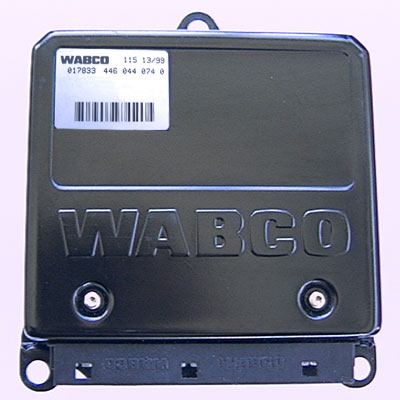Realtime live display of the information the electronic control unit of the selected vehicle system is currently deriving from its input sensors.
- Wheel speed sensor voltage: This shows the DC Voltage for the right front wheel speed sensor. Expected values are between 2.0 to 2.4 Volts. The wheel speed sensors are different to the conventional wheel speed sensors used on other Land Rover products. Conventionally, wheel speed sensors have an interference fit with the hub or back plate. This positions the sensor close to a reluctor ring. The sensors used are incorporated into the inboard wheel bearing, on both front and rear hubs. This bearing assembly is a sealed unit and has no replaceable parts. Also different, is the wire from the wheel speed sensor. Land Rover has, historically used a wheel speed sensor employing a signal wire inside a shielded earth wire. The new wheel speed sensors have a twisted pair of wires. This offers some electrical advantages over two straight wires, such as the signal being less susceptible to electrical noise or interference and it generates less electrical noise. The wires can also be balanced together (similar electrical properties) to ensure voltage losses are minimized. Like a conventional wheel speed sensor, the signal created is an AC sine wave. This wave is generated in the inductive sensor by a sixty-tooth reluctor, machined into the wheel bearing inner race. The frequency of this signal supplies the ABS ECU with the information it needs to determine the speed of the individual wheels and is used in the calculation of vehicle speed or vehicle reference speed.
- Outlet valve: This shows the voltage being applied to this valve by the ABS ECU. When driven the voltage should be around 2.8 to 3.6 Volts and when not being driven should be around 0 to 0.5 Volts.
- Inlet valve: This shows the voltage being applied to this valve by the ABS ECU. When driven the voltage should be around 2.8 to 3.6 Volts and when not being driven should be around 0 to 0.5 Volts.
- Wheel speed: The wheel speed in KPH. The ABS ECU cannot detect wheel speeds less than 1.8 KPH. The wheel speed sensors are different to the conventional wheel speed sensors used on other Land Rover products. Conventionally, wheel speed sensors have an interference fit with the hub or back plate. This positions the sensor close to a reluctor ring. The sensors used are incorporated into the inboard wheel bearing, on both front and rear hubs. This bearing assembly is a sealed unit and has no replaceable parts. Also different is the wire from the wheel speed sensor. Land Rover has, historically used a wheel speed sensor employing a signal wire inside a shielded earth wire. The new wheel speed sensors have a twisted pair of wires. This offers some electrical advantages over two straight wires. Such as the signal being less susceptible to electrical noise or interference and it generates less electrical noise, the wires can also be balanced together (similar electrical properties) to ensure voltage losses are minimized. Like a conventional wheel speed sensor, the signal created is an AC sine wave. This wave is generated in the inductive sensor by a sixty-tooth reluctor, machined into the wheel bearing inner race. The frequency of this signal supplies the ABS ECU with the information it needs to determine the speed of the individual wheels and is used in the calculation of vehicle speed or vehicle reference speed.
- Brake switch 1: This shows the status of the brake switch no 1.
- Brake switch 2: This shows the status of the brake switch no 2.
- Pressure switch 1: This shows the status of the pressure switch no 1.
- Pressure switch 2: This shows the state of the pressure switch no 2.
|
 WABCO D TYPE (FREELANDER) - System Overview
WABCO D TYPE (FREELANDER) - System Overview WABCO D TYPE (FREELANDER) - System Overview
WABCO D TYPE (FREELANDER) - System Overview SM017 - WABCO D TYPE (FREELANDER) - System Help file
SM017 - WABCO D TYPE (FREELANDER) - System Help file WABCO D TYPE (FREELANDER) - Known Fitments
WABCO D TYPE (FREELANDER) - Known Fitments WABCO D TYPE (FREELANDER) - Physical Details
WABCO D TYPE (FREELANDER) - Physical Details
 WABCO D TYPE (FREELANDER) - Pin Outs
WABCO D TYPE (FREELANDER) - Pin Outs SM017 - WABCO D TYPE (FREELANDER) - Diagnostic Capabilities (Read Fault Codes)
SM017 - WABCO D TYPE (FREELANDER) - Diagnostic Capabilities (Read Fault Codes) SM017 - WABCO D TYPE (FREELANDER) - Diagnostic Capabilities (Clear Fault Codes)
SM017 - WABCO D TYPE (FREELANDER) - Diagnostic Capabilities (Clear Fault Codes) SM017 - WABCO D TYPE (FREELANDER) - Diagnostic Capabilities (Settings)
SM017 - WABCO D TYPE (FREELANDER) - Diagnostic Capabilities (Settings) SM017 - WABCO D TYPE (FREELANDER) - Diagnostic Capabilities (Inputs)
SM017 - WABCO D TYPE (FREELANDER) - Diagnostic Capabilities (Inputs) SM017 - WABCO D TYPE (FREELANDER) - Diagnostic Capabilities (Outputs)
SM017 - WABCO D TYPE (FREELANDER) - Diagnostic Capabilities (Outputs) SM017 - WABCO D TYPE (FREELANDER) - Diagnostic Capabilities (Other)
SM017 - WABCO D TYPE (FREELANDER) - Diagnostic Capabilities (Other)